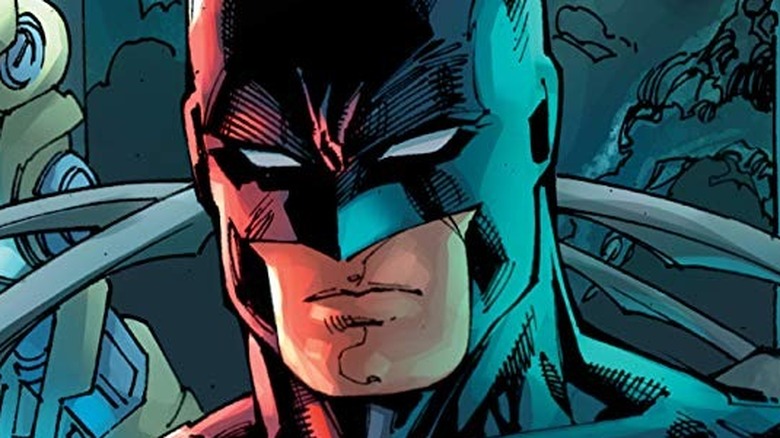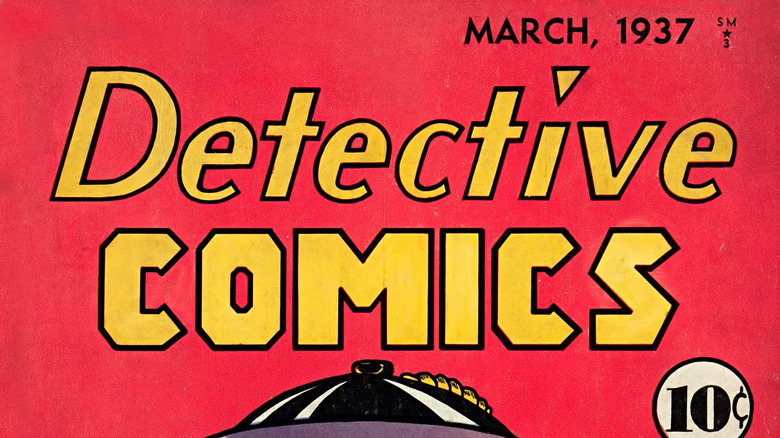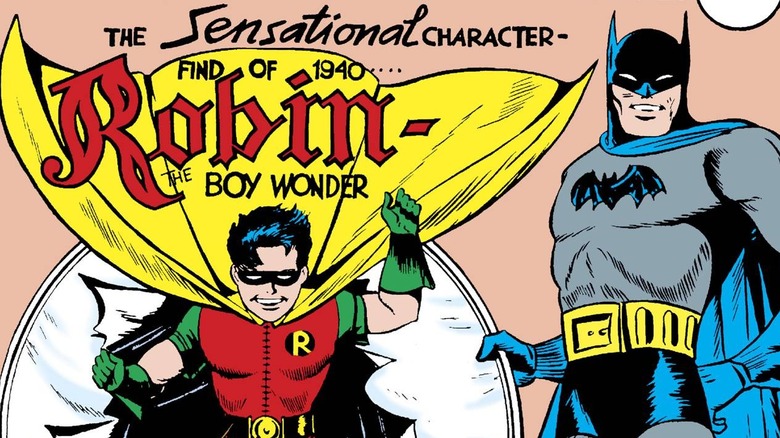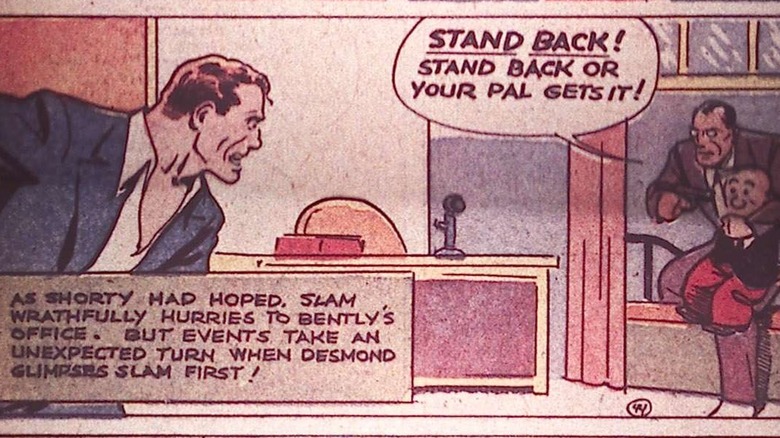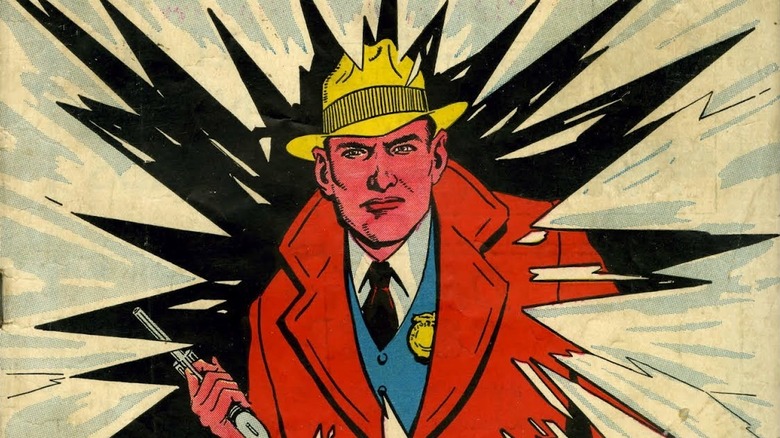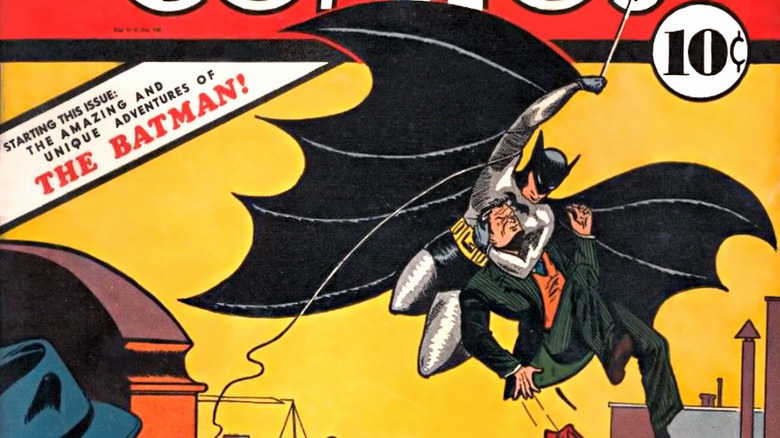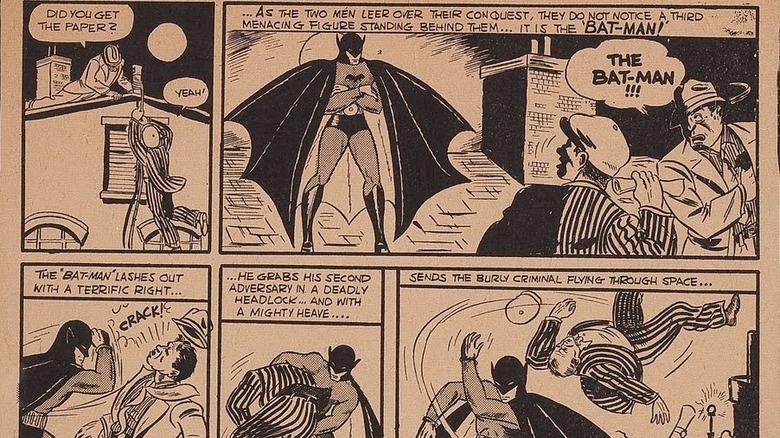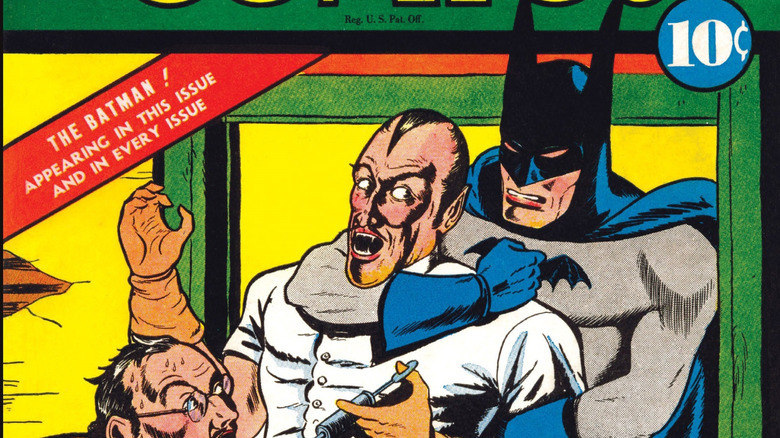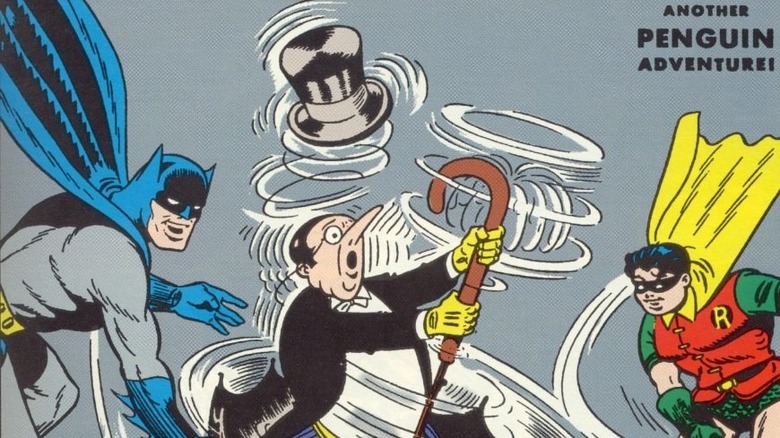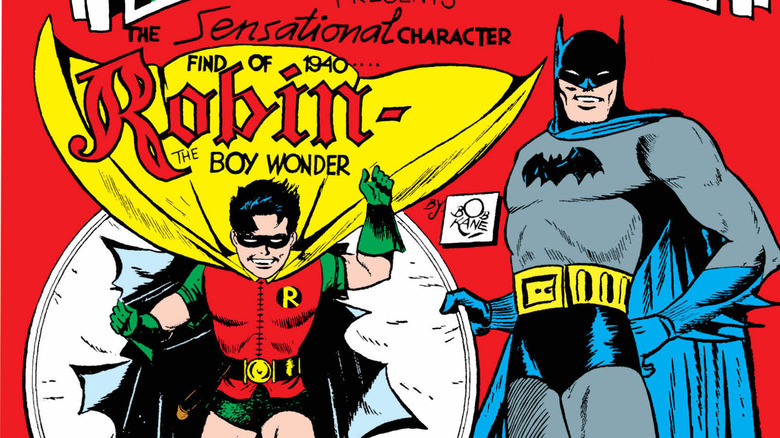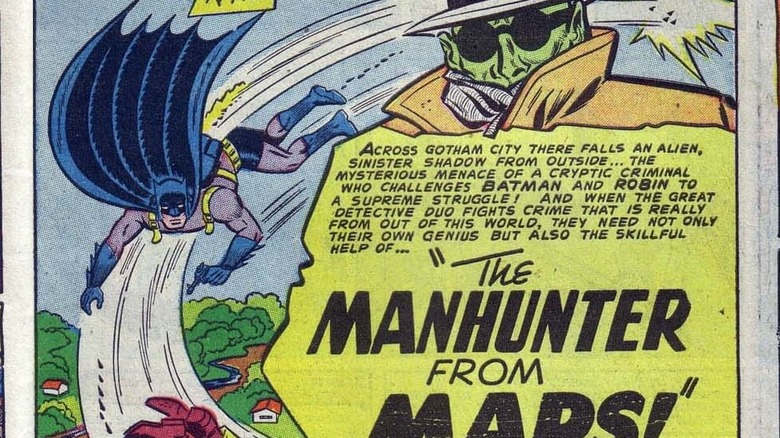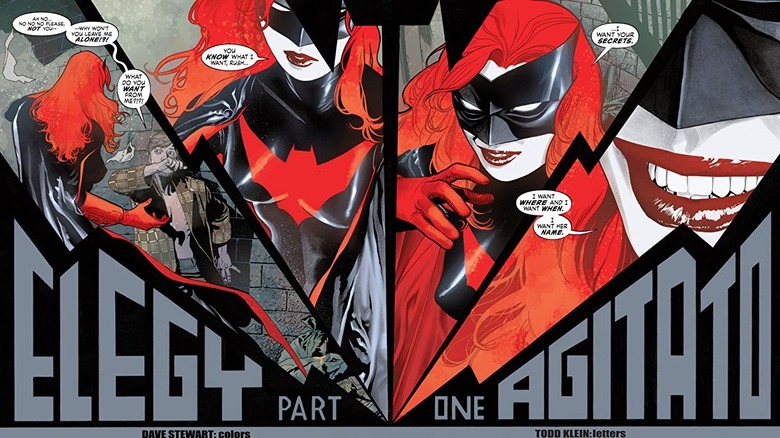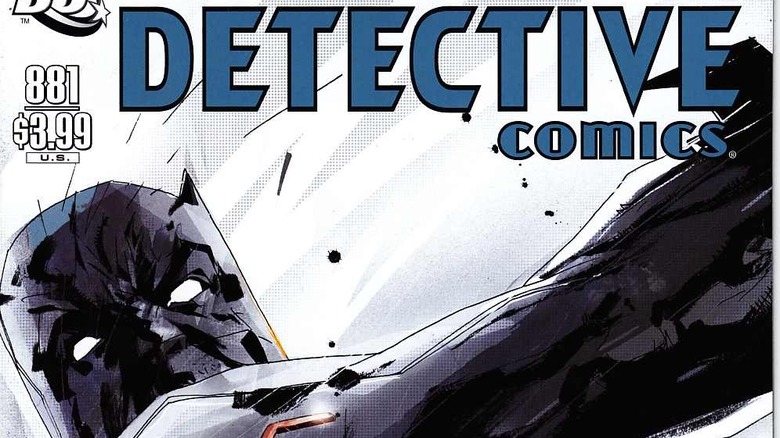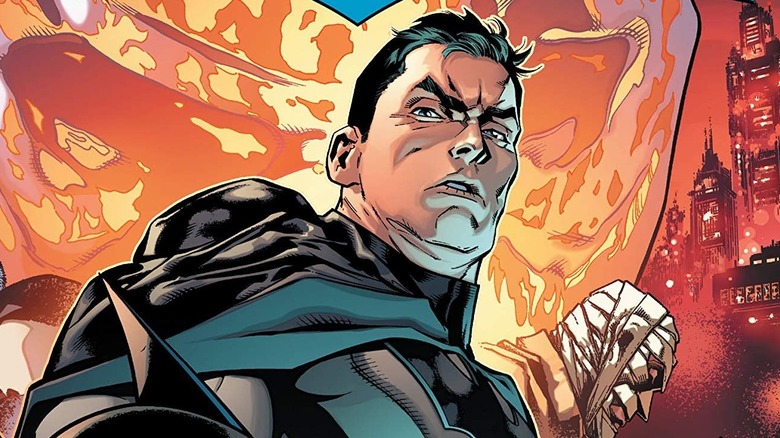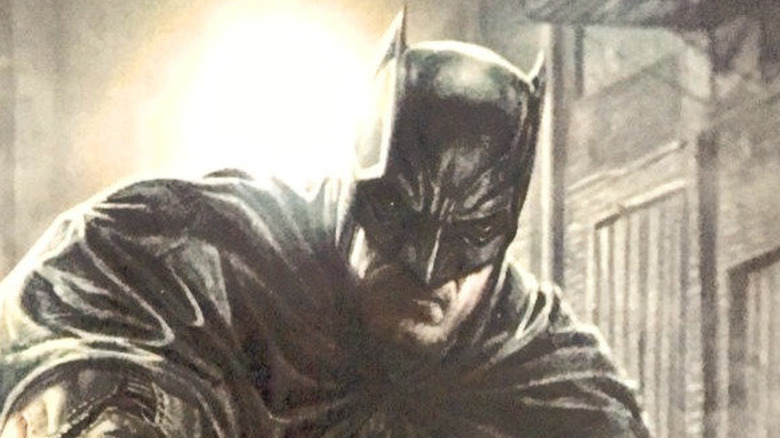The Untold Truth Of Detective Comics
"Detective Comics" is without a doubt one of the most important comic book series of all time, as it has been the launching pad for countless classic characters ever since the first issue appeared on newsstands in 1937. In fact, many of the characters who first appeared in this legendary title have not only continued to be featured prominently in comics today, but have gone on to be portrayed by A-list actors in numerous big-budget films and TV shows.
In addition to giving the world innumerable characters, "Detective Comics" has served as the creative incubator for many aspiring writers, artists, inkers, colorists, and other iconic figures in the comic book field. Even today, some of the industry's most talented up-and-coming creators continue to work on the title.
Because "Detective Comics" has a history that's as long and complex as the continuity that takes place in its own pages, there are bound to be stories and facts about the never-ending series that even the most devoted comic book collector may not be privy to. So let's take a look at the untold truth of "Detective Comics."
It was the final title published before National Allied Publications became DC Comics
As depicted in the book "DC Comics Year By Year," before DC Comics was DC Comics, the publisher was known as National Allied Publications, founded in 1934 by former U.S. Cavalry major and entrepreneur Malcolm Wheeler-Nicholson. The publisher's first title, the tabloid-sized "New Fun: The Big Comic Magazine," was unique for its time as it was one of the few anthology series that featured original stories not reprinted from other newspaper strips. While National Allied Publications did publish some superhero stories, they released a wide range of tales, including Westerns, humor, and adventure stories. But it was in 1935 that National would plant the seed for DC Comics' future, when Jerry Siegel and Joe Shuster (who would create Superman just a few years later) conceived of Doctor Occult, widely considered to be the earliest recurring superhero still used by DC today.
While Wheeler-Nicholson would not be with the company for much longer, he did oversee the publication of one last title before he left, and that was "Detective Comics," released in 1937. At the time, Wheeler-Nicholson was in debt to Harry Donenfeld, a printing plant owner, magazine distributor, and pulp magazine publisher. The only way that Wheeler-Nicholson could publish "Detective Comics" was if he brought on Donenfeld as a partner, and with that, a legendary comic book series was born, marking a significant change for National Allied Publications.
DC is short for Detective Comics
In order to publish "Detective Comics," Malcolm Wheeler-Nicholson partnered with Harry Donenfeld to form a new company named, of course, Detective Comics, Inc. After some financial issues, Wheeler-Nicholson was pushed out and Detective Comics, Inc. purchased his National Allied Publications at a bankruptcy auction. At the time, none of the titles released by the company had any logos, but that all changed in 1940 when they began to be released with the label, "A DC Publication." Because Superman was their most popular character, Detective Comics, Inc. changed the logo to say "A Superman-DC Publication" in 1941.
The company's name underwent another evolution in 1946, as Donenfeld consolidated various companies — including National Allied, Detective Comics and All-American Publications — into National Comics Publications. But the only change to the logo was that "National" was included in "A Superman-DC Publication." This was the standard logo printed on their comics until 1960, when National Comics Publications was bought by a consortium that had also bought Warner Bros. To reflect this change, various logos were tried before the company settled on "DC" as its general logo in the early 1970s.
Because the company had been using "DC" as its logo for decades up until this point, fans still referred to the company as a whole as "DC Comics." But the company underwent another major change in 1976 when Jenette Kahn became the publisher and reorganized the company as DC Comics, Inc., with the logos reflecting this soon after. While the company has used numerous logos since then, they always stuck to those two iconic letters.
Detective Comics started as an anthology series
Before "Detective Comics" became the primary title for one of the most popular characters of all time, it was an anthology series that focused primarily on the crime genre so popular at the time. Because it consisted of stories too short for standalone publication, a wide range of characters would be featured in each issue, which became a testing ground for up-and-coming writers and artists.
One of the most enduring characters to come out of the early days of "Detective Comics" was Samuel Emerson "Slam" Bradley, a private detective conceived by Malcolm Wheeler-Nicholson and developed by Jerry Siegel and Joe Shuster. While Slam may not be as well known today, he's since popped up throughout the DC Comics universe in various series, including several "Superman" titles in the 1990s, Darwyn Cooke's 2003-2004 series "DC: The New Frontier," and some "Batman" titles. Slam has also appeared outside of the comics, having been portrayed by Kurt Szarka in the "Batwoman" episode "How Queer Everything Is Today!"
Another important character who made his debut in the formative years of "Detective Comics" was Cyril "Speed" Saunders, an adventurer and detective. Despite appearing in more than 50 issues of "Detective Comics" in the 1930s and 1940s, Saunders doesn't show up much in modern comics these days. However, he was eventually revived in a supporting role as the retconned grandfather of the current Hawkgirl, Kendra Saunders, and as the first cousin to the original Hawkgirl, Shiera Sanders Hall. Renowned comic book writer James Robinson and "Dark Knight" co-writer David S. Goyer would use the character in 1999 for "JSA Secret Files" #1.
Siegel and Shuster worked on Detective Comics before creating Superman
Jerry Siegel and Joe Shuster may be best known for their collaboration in creating the Big Blue Boy Scout, but prior to their momentous contribution to the pantheon of comic book superheroes, they cut their teeth working on various stories for "Detective Comics," with Slam Bradley being one of their most famous collaborations in the book.
Siegel wrote stories for the first 55 issues of "Detective Comics." One of the more prominent characters he worked on for the title was "Spy," a serial that followed the adventures of Bart Regan, a former Federal Agent who became a spy for the Secret Service. The story began in "Detective Comics #1" in 1937 and ended in issue #83 in 1944. Shuster, meanwhile, penciled stories for the first 32 issues of "Detective Comics."
It's fascinating to realize that, while these two comic book creators spent most of their formative years in the industry working on stories that would have little lasting impact on popular culture, they were secretly sitting on a character who would go on to become one of the most recognizable fictional figures around the world.
Batman made his first appearance in Detective Comics
Written by Bill Finger and drawn by Bob Kane, the first-ever story to star Batman was published in "Detective Comics #27," along with Speed Saunders in "Killers of Kurdistan," Buck Marshall in "Bullet Bluff," Bart Regan in "The Mysterious Murders," the Crimson Avenger in "Murder on the Oceanic Line Docks," and several other stories. With so many stories about characters largely forgotten, there's no way that their creators could have known that they'd be featured in what would go on to become one of the most important comic books of all time.
Batman's first tale was "The Case of the Chemical Syndicate," and also introduced beloved character Commissioner Gordon. In the story, Gordon is investigating the death of Lambert, a chemical manufacturer. Lambert's murder was ordered by one of his partners, Alfred Stryker, who was trying to take control of the company. Batman, after apprehending the other conspirators, confronts Stryker to bring him in. However, because Batman hasn't developed his "no killing" rule at this point in his career, he shoves Stryker into a vat of acid, killing him. Even more surprising (at least by today's standards) is that Batman calls Stryker's gruesome death "a fitting end for his kind." At the end of the story, Gordon explains this wild tale to his friend Bruce Wayne, who dismisses it as mere nonsense. However, in a twist that would surprise no one ever, it's revealed that Bruce Wayne is in fact Batman.
Detective Comics #27 is one of the most valuable comic books in existence
Who would have thought that something that once cost 10 cents in the late 1930s would eventually be worth the value of a massive house only decades later?
We've mentioned how important "Detective Comics #27" was to popular culture, but it turns out it's important enough for someone to shell out over a million dollars to own, which someone did in 2010. In a 2010 article in The Guardian, it was reported that that issue was purchased at $1,075,500 by an anonymous buyer through Heritage Auction Galleries. The purchase was so surprising that it even stunned Barry Sandoval, director of operations of Heritage's comics division, who said, "it pretty much blew away all our expectations and now it's the highest price ever raised for a comic book." The seller of the iconic issue had previously purchased it in the late 1960s for $100, which is still quite an increase in value. And to think, the series was published in a last ditch effort to save a company from going under.
This record sale (which has since been shattered) is actually quite funny, as only a few days prior to the sale, an original 1938 edition of "Action Comics #1" — the first appearance of Superman — sold for slightly less than the amount paid for the historic "Detective Comics" issue. Hopefully Bats and Supes won't let money ruin their friendship.
Detective Comics became a Batman-centric title in 1940
"Detective Comics" may have started off as an anthology series, but its evolution into a Batman-centric title started fairly early on. Prior to 1940's "Detective Comics" #35, each issue of the series featured a different main story — with an accompanying cover — along with several supporting stories. Until then, Batman had only been the main feature on several occasions, but his rising popularity (as seen by Batman's face above the title, even on covers he wasn't featured on) led to the book focusing on the Caped Crusader, which continues today. Even when Batman got his own solo series in 1940, "Detective Comics" still kept the spotlight on the Dark Knight while still including backup stories.
Since then, Batman has been featured in countless other spinoff series. But while those books have experienced varying degrees of success, "Detective Comics" has always remained the cornerstone of the Batman mythos. In recent years, "Detective Comics" has often functioned as a more team-focused series, highlighting other members of the Bat-family.
Some of Batman's greatest villains first appeared in Detective Comics
"Detective Comics" may be primarily known for introducing the masses to the World's Greatest Detective, but the long-running series has also given us some of the most iconic villains in Batman's rogues gallery.
Professor Hugo Strange made his first appearance in 1940's "Detective Comics #36," which saw the mad scientist using a special fog machine to provide extra cover for him and his men to carry out various crimes undetected. Of course, Batman destroys the machine and puts Strange in jail, yet Strange still believes he can best Batman, which he's been trying to do for decades now.
Basil Karlo, aka Clayface, made his debut in 1940's "Detective Comics #40," where he's depicted as a former actor who goes into a rage because one of his films is being remade without him, and seeks revenge against those involved with the new version of the film.
Oswald Cobblepot, known as the Penguin, made his grand entrance in 1941's "Detective Comics #58," wherein he masterminds a large crime wave in Gotham City, stealing priceless items and using his signature trick umbrellas.
The ever-duplicitous Two-Face was introduced to the world in 1942's "Detective Comics #66." This origin story reveals how the young yet talented district attorney Harvey Dent had his face irreparably damaged when criminal "Boss" Maroni threw acid on him in court. His sanity shattered and his sense of justice warped, Two-Face then goes on to lead a life of crime and violence.
Many other classic Batman characters debuted in Detective Comics
While Batman's villains often get much of the attention, the Dark Knight also has an impressive set of allies and supporting characters who have played major roles in his life over the years. In fact, many of these characters were first seen in "Detective Comics," further establishing the title's lofty place in comics history.
1940's "Detective Comics #38" marked the first appearance of Dick Grayson, aka Robin, revealing his legendary origin story in which his parents, the Flying Graysons, are murdered. He's taken into the custody of Bruce Wayne, who knows the pain of being orphaned so early in life. It's not long until the two form one of the most beloved partnerships in comic book lore.
While several heroines have taken up the mantle of Batwoman over the years, the honor of being the first Batwoman will always go to Kathy Kane, who made her first appearance as the titular character in 1956's "Detective Comics #233." Having both lots of money and a background in acrobatics, Kane would go on to have a long career fighting crime.
One of the weirder characters in the Bat-family is Bat-Mite, an imp-like creature from an alternate reality who worships Batman so much, he even dresses like him. This zany little character first entered into the pantheon of superhero comics in 1959's "Detective Comics #267," and has continued to sporadically annoy Batman ever since.
Martian Manhunter made his first appearance in Detective Comics
The Martian Manhunter (J'onn J'onzz) is a Mars-born entity who has a wide range of superpowers, including enhanced strength, flight, shapeshifting, telepathy, and more. Of course, it's a good thing that such a powerful being is on the side of the angels, as Martian Manhunter has been a valued member of the Justice League since they first exploded onto the scene in 1960's "The Brave and the Bold" #28. He's appeared in various lineups of the League and is still an important character in the comics. You may have also seen the Martian Manhunter outside of the comics, as he's appeared in such TV shows as "Smallville," "Supergirl," and "The Flash;" various DC Animated Universe films; and most recently in "Zack Snyder's Justice League."
However, all of that illustrious history had to begin somewhere, and that was in 1955's "Detective Comics" #25 in a backup story titled "The Strange Experiment of Dr. Erdel." It chronicles Professor Mark Erdel who, in his experiments in teleportation, unwittingly beams J'onn J'onzz to Earth from Mars. As J'onzz tours the planet, he's disturbed by the violence and lawlessness that still plagues it, as his home planet has evolved to a state where such atrocities are practically non-existent. He decides to stay on Earth to fight crime, taking on the identity of John Jones and becoming a detective in the police department of Middletown.
Batwoman briefly replaced Batman as the featured character
"Detective Comics" has been a Batman-centric series for decades now, but there was a time when the World's Greatest Detective was dead (well, sort of) and the title was headlined by Batwoman.
Following the events of "Final Crisis," Batman is seemingly dead, having been killed by Darkseid's Omega Beams. Batman is actually not dead, having instead been thrown back in time, but this isn't known to the rest of the DC Universe. During this time, "Detective Comics" was temporarily halted and replaced with the three-issue miniseries, "Batman: Battle for the Cowl," which chronicled various Bat-family characters as they vied for who should take up the mantle of Batman.
While Dick Grayson ultimately ended up as the new Batman, Kate Kane (having been introduced in the year-long series "52") became the new Batwoman, as well as the lead character of "Detective Comics" for seven issues.
Kate Kane is more than an updated version of the Silver Age Kathy Kane, the first Batwoman. Like her previous incarnation, Kate is a wealthy Gotham City socialite who is inspired by Batman to put her vast resources to good use and fight crime. But unlike Kathy, Kate is the cousin of Bruce Wayne and is a lesbian, having the unique distinction of being the most prominent gay superhero in a DC comic.
Like many other characters who made a splash in "Detective Comics," Kate Kane has had an impressive career outside of the comics, having been seen in The CW's "Arrowverse" shows "Arrow," "The Flash," "Supergirl," and — for one season — her own self-named series.
After 883 issues, Detective Comics was relaunched in DC's New 52
It can be daunting for a new reader to dive into a comic book series that's at issue #850; is it really necessary to have read all previous 849 issues in order to understand what the story is about? While most mainstream comics aren't that inaccessible to fresh audiences, there's no doubt that decades and decades of continuity can make it difficult for someone to just dive in.
Luckily, DC Comics began their New 52 initiative in 2011, featuring the relaunch of their entire universe and giving readers the perfect jumping-on point. All of the company's main titles were given new designs, backstories, and, of course, new numberings. "Detective Comics" was no exception, as the series' original run ended at issue #881 and was restarted with a brand-new #1.
While the New 52 initiative overall got a lukewarm response from fans and critics, "Detective Comics" was one of the relaunched titles that was lauded, even winning the award for "Best Series" in 2012 at the Stan Lee Awards. This new version of "Detective Comics" also went back to its roots by including a backup feature, beginning with issue #8, that followed Harvey "Two-Face" Dent and his attempts to restore his life after a stay in Arkham Asylum.
One of the highlights of the New 52 "Detective Comics" series was the special mega-sized issue #27, which celebrated Batman's 75th anniversary with contributions from various top industry names, including Bryan Hitch, Gregg Hurwitz, Scott Snyder, Tony Daniel, Mike Allred, and many others.
DC Rebirth saw Detective Comics return to its original numbering
In 2016, DC Comics launched its DC Rebirth initiative, which was inaugurated with a special 80-page one-shot issue that established the new continuity and planted the seeds for storylines going forward.
As part of this relaunch, new series were introduced and legacy series were restored to their original numberings, with "Detective Comics" among them. While the original series ended at #881, the 52 issues from the New 52 initiative were added to the total, which meant that "Detective Comics" resumed at issue #934 under DC Rebirth.
Written by James Tynion IV with art by Eddy Barrows and Alvaro Martinez, the newly-revamped "Detective Comics" focused on a team led by Batman and Batwoman that included members Red Robin (Tim Drake), Orphan (Cassandra Cain), Spoiler (Stephanie Brown), and Clayface (Basil Karlo), as well as others who would later join the team. While "Detective Comics" generally spotlighted the Dark Knight's solo adventures, this new incarnation of the title was a nice change of pace that gave supporting characters a chance to shine. The series went through various creative teams, until writer Peter Tomasi became a regular writer on issue #994, leading the series well past the #1,000 mark.
It was once the longest continuously published comic book in the US
In 2009, it was announced that "Detective Comics" had been recognized by Guinness World Records as the longest-running comic book in the United States. Craig Glenday, editor-in-chief of Guinness World Records, bestowed the award to then-DC Comics president and publisher Paul Levitz in DC's booth at that year's San Diego Comic-Con. Levitz was the perfect person to accept the award on the series' behalf, saying, "As the earliest surviving editor of 'Detective,' a title which I edited from 1978-1980, I'm doubly honored to accept this recognition."
Not a bad legacy for a comic book published by a company whose owner was on the brink of financial ruin, eh?
However, as impressive as that feat was, the record set by "Detective Comics" would eventually be overtaken by another title: "Action Comics," famous for introducing the world to Superman 80 years prior. On July 19, 2018 at San Diego Comic-Con, DC publishers Dan DiDio and Jim Lee were presented with the award for the longest-running superhero comic book series. While "Detective Comics" may no longer hold this distinction, at least DC Comics will be happy that the title's sister series now holds the record.
